北京多向界建筑设计
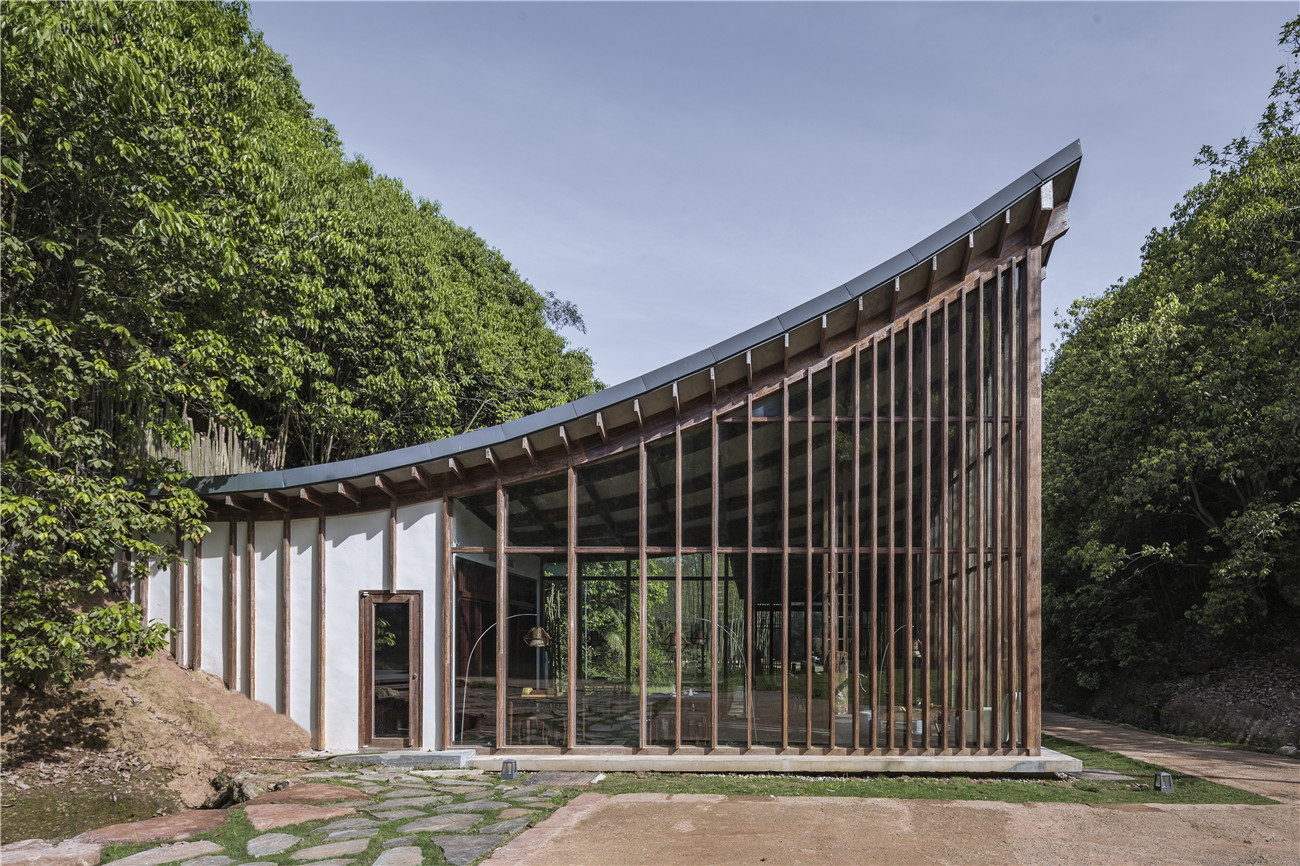
设计单位 北京多向界建筑设计
项目地点 湖南省平江县白茅村
建造时间 2014年6月—2018年3月
建筑面积 3800平方米
“全国诗人半在湘”,湖湘文化所具有的最鲜明的特征即是其内涵的“诗性”。双溪书院则以其独特的山水人居的方式——依山取势,临溪而居,分合布局,错落有序——来重新诠释这一诗性。在这里,似乎所有物理空间的构想都应当被赋予某种情境:游山、访古、寻幽、高卧、倚竹、观鱼、濯足、鼓琴、品茶、焚香。这些诗意的片段都自然地再现,并又被重新置入当代人文精神与生活之中,展现出新的“诗性”。正如海德格尔所倡导的:“正是诗意首先使人进入大地,使人属于大地,并因此使人进入居住。”在此地,诗意成为最自然的生活,也成为禅境与超然的场景。
There is an old saying goes like this: "Half of Chinese poets are in Hunan", which shows the most distinctive feature included in Hunan's culture, that is, "poetic". Such poetic feature can be reinterpreted by the unique scenery residence of Shuangxi Academy -- laying alongside mountains and beside brooks with randomly scattered but well clustered residence. Here, all kinds of spatial designs in architecture seem to be given certain meanings: no matter it is enjoyable sightseeing or peaceful resting, bamboo leaning or fish viewing, footbath enjoying or musical instrument playing, tea tasting or incense burning, you will always find natural reflections of poetry inside. With such poetic segments melted into humanistic spirit and life, refreshed poetic symbols are created. Just like what Martin Heidegger advocated: "it is poetry that leads us to the land and makes us belong to it and live on it." In Shuangxi Academy, poetry has entered normal lives and become a place for Zen and aloofness.

这一诗意的诉求使建筑设计在一开始就被赋予了明确的画面感。如何让建筑真正地融入环境,从而加强这种场景感而不会带来破坏,成为了前期“规划”的一条基本准则。说是规划,实则更像一种随地形变化的,自然的“安排”。场地中有几条枝杈状的,11—14米宽的溪谷向不同的方向蜿蜒,而建筑则被契入山谷之中,只呈现出谷口的一个立面。于是,双溪书院的七个单体建筑,除了接待大堂和茶室两个公共建筑外,都被分别隐藏在四条张开的山谷内,互不相望,各自以各自独特的视角存在。这种关系有些像传统山水画中的散点透视,每个局部自成一体,又能够“拼贴”成一幅完整的画面。
The pursuit of poetry gives architectural design a sense of picture even at the beginning. On the one hand, the basic line for designing is to find a way of embedding buildings into their surroundings without damaging the scenario but enhancing it instead. It is actually more of a natural arrangement than artificial design -- pronged brooks of 11m to 14m width twist toward different direction, engraving buildings into the valley and presenting to us the facade of valley entrance only. As a result, seven single buildings of Shuangxi Academy, except for the reception hall (or restaurant) and tea room, are all hidden in four open valleys, each with its unique view. Such structure is just like cavalier perspective used in traditional Chinese painting - independent components which together form an integrated picture.
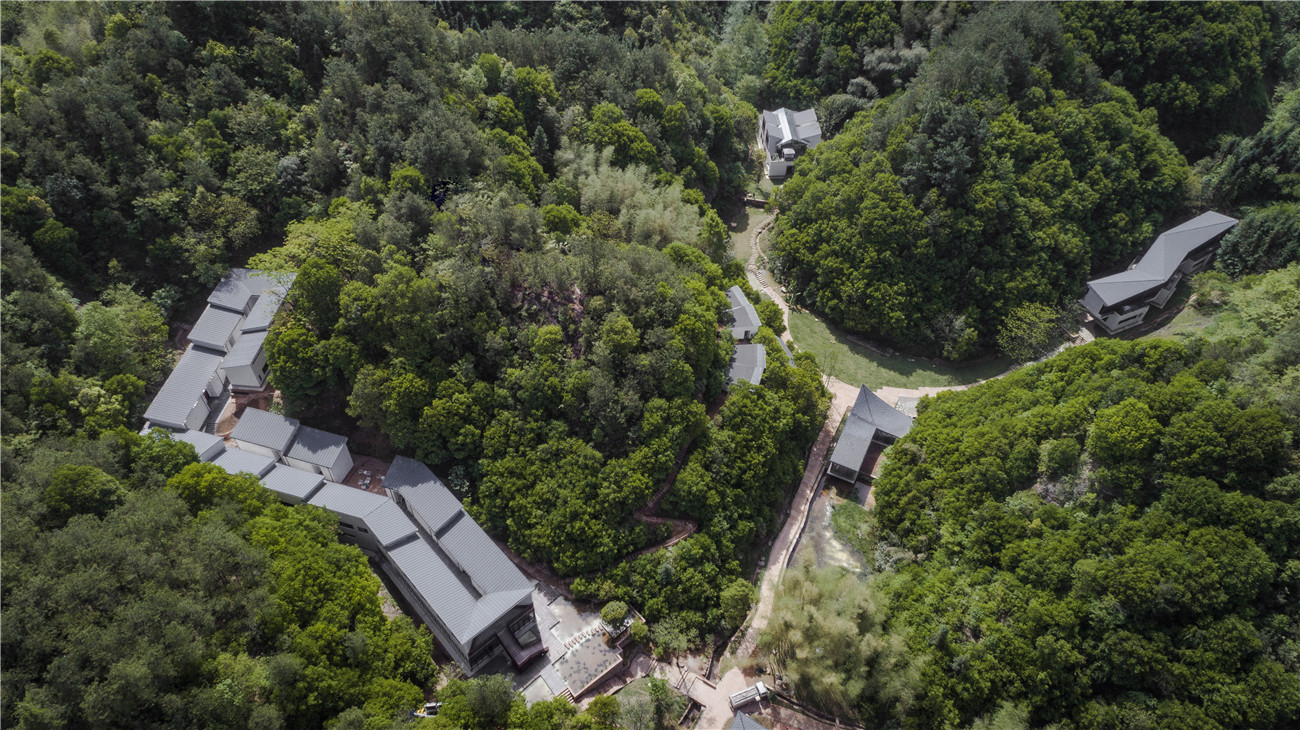
另一方面,在建筑的风格样式上,双溪书院尝试运用现代的建筑材料和结构技术来体现地域传统。从内天井的结构布局,木构构架与高耸的白墙,连续的灰瓦坡顶,到石、木、瓦等材料肌理,这些形象既来源于当地的传统民居建筑,同时也是对更广义的中国南方民居的片段提取和抽象提炼。在建造上,除了运用常规的混凝土框架作为基础结构,还使用了大量的竹钢,铝板金属屋面,和一部分GRC(玻璃纤维加强混凝土)材料,这些材料的组合也对施工工艺提出了新的要求。在风格上,双溪书院的七个单体建筑,总体有相似的元素,但又因山势而样貌迥异,各有特点。
On the other hand, in the architectural style, modern material and structural technology are applied, trying to recreate traditional local building images. All these architectural design images like interior courtyard, wood frame, white wall and tiled slope, as well as elements like brick, wood and tile, are originated from traditional local buildings or partly and abstractly extracted from architectural symbols of southern China. As for construction, in addition to traditional concrete frame, materials of bamboo steel, aluminum plate metal roof and GRC (glbumm concrete) materials are also used, which raises new requirements to construction technology. As for styles, seven single buildings of Shuangxi Academy share similar elements and different features at the same time due to the landform of mountains.
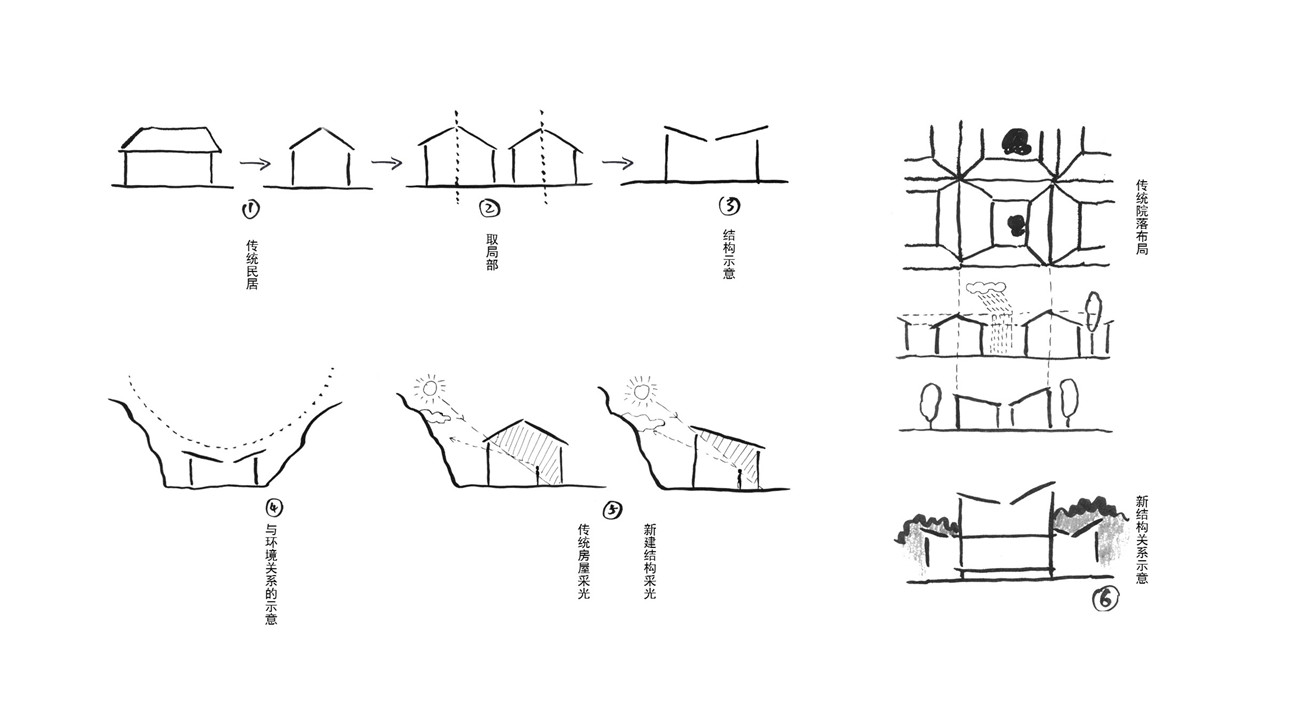
山谷的场地限定了人的视线,使人在游览时只能从特定的角度开始。在这些特定视角形成的“画面”中,近景可能是几棵树或一丛竹林,远景则是向两侧蜿蜒升高的山脊,使建筑自然成为画面的中间层次,也使立面超越了体量本身,变的更加重要。
Because valleys limit people's vision, so tourists can only start visiting from a specific angle. Viewing from these angles, tourists will first see trees or bamboo forest, then divert their attention to further mountain ridges, positioning the sites where they stand as the medium tier of the whole picture, and surpassing the facade's mass over its flat form.
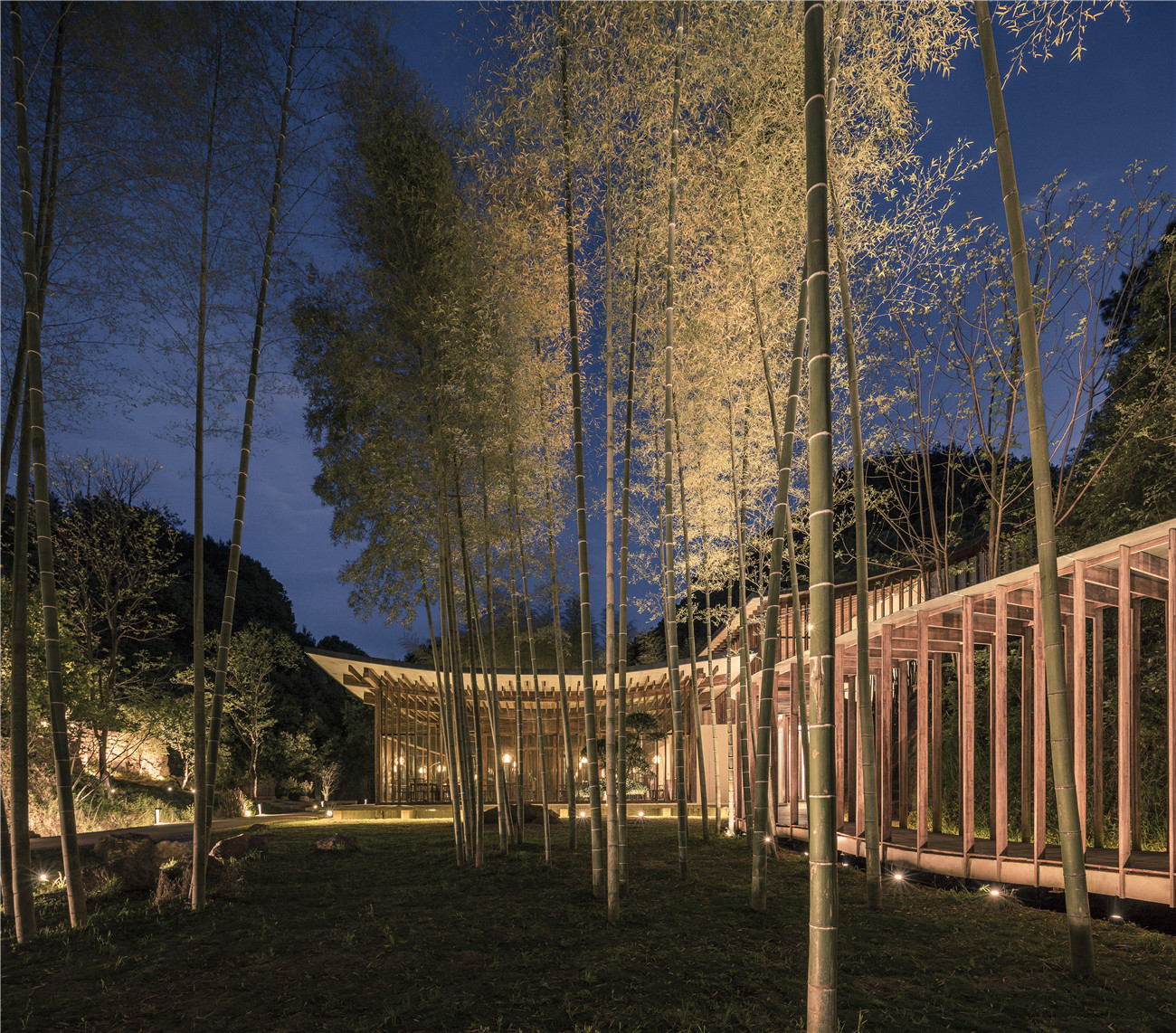
接待堂的顶部是一条向下弧的屋檐线,立面是简洁的竖向线条。尽管没能使用传统建筑典型的灰瓦大坡屋顶,但檐口以下由层层的椽子向立柱传力的基本结构,表达出与传统结构之间的联系。其他的侧立面则直接复制自正立面,最终形成一个围绕“天井”的正方形布局。这个“回”字形的结构启发自传统平江地区的民居内天井的布局形态。接待堂向四周翘起的屋檐呼应着周边天际线,也为室内带来更好的光线和更通透的观景效果。
At the top of reception hall, the roof line is downward arc and facade is simplified as a vertical line. Though the typical design of tiled slope is not used here, layered rafter under the cornice can still show their links with traditional structure. Other side elevations are the direct copies of the front elevation, forming an square structure that surrounds "courtyard". Basically, such structure that resembles Chinese character "回" is inspired by the interior courtyard of residence in Pingjiang district. Turnup eaves of the reception hall correspond to above skyline and also bring better hall's light and a more transparent view.
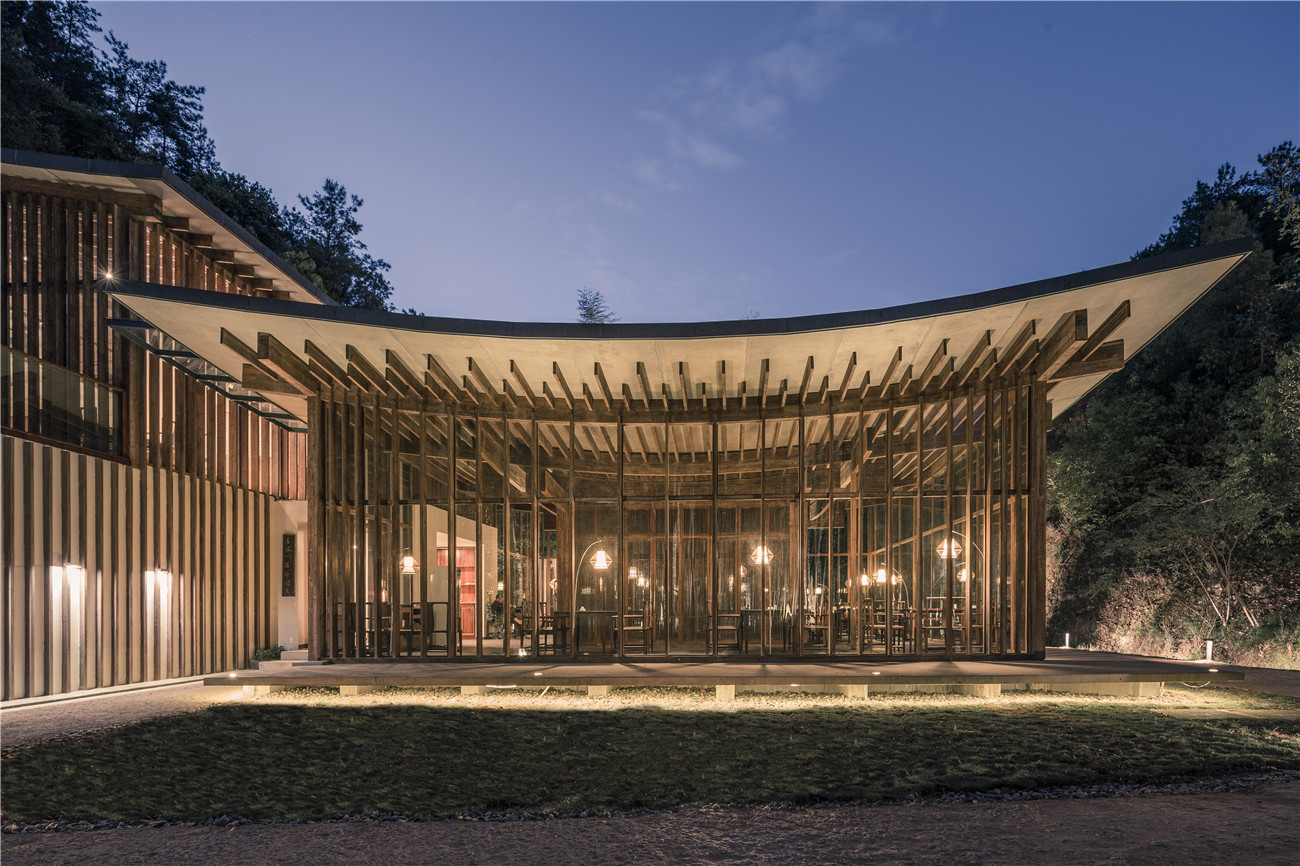
西侧连接接待大堂的部分几乎完全契入山体,布置有厨房、餐厅包间、小展厅等辅助功能。一个巨大的单坡屋顶顺山势倾斜,与接待大堂的屋顶形成叠落的关系。为了达到更轻薄的形体效果,建筑主体采用竹钢搭建;每根竖向的立柱都为承重柱,从而达到均匀受力的效果。“柱”与“梁”的连接部分简单地交错堆叠,在形式上产生类似斗拱结构的效果。屋顶采用GRC预制板,直接“平落”在竹钢框架上。屋顶面层采用金属瓦而非传统瓦,大大减轻了屋顶重量,使整体结构轻量化,传达出具有现代气质的,南方建筑的秀美。
The west part that connects reception hall is almost embedded in the mountain and mainly serves as kitchen, restaurant or small exhibition hall. A huge single-slope roof tilts along mountain line, stacking and overlapping with the roof of reception hall. To thicken building structure, its main body is constructed by bamboo steel. Each vertical pillar is designed as a king tower in order to even the roof stress. Pillars and beams simply overlap with each other, forming a bucket arch in the form. The hall roof is made by GRC plate, spreading right upon bamboo steel structure. The roof surface is covered by metallic tile instead of traditional tile, which not only lowers roof load, but also lightens body structure, expressing to us a streamlined modern beauty of southern China.
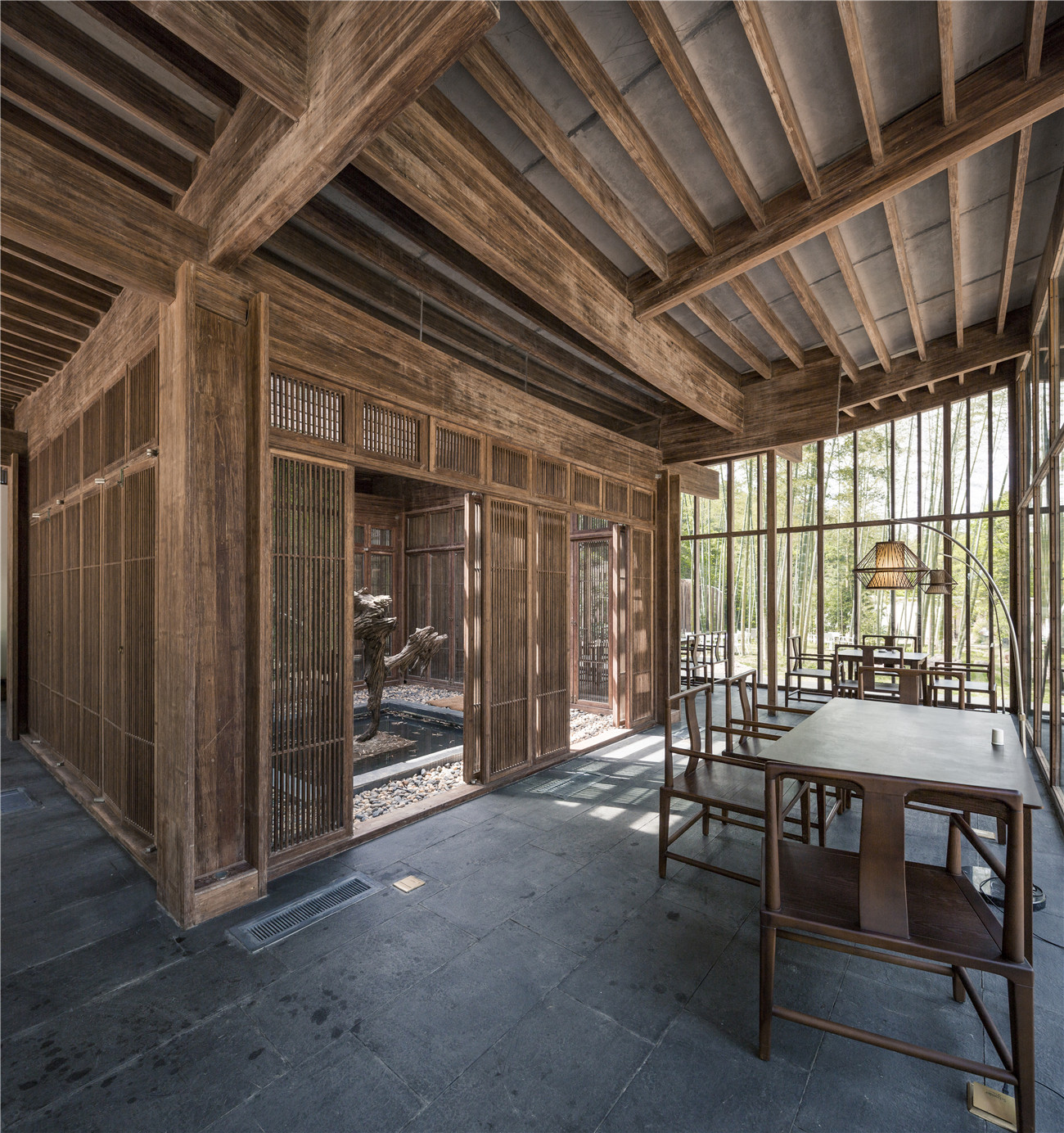
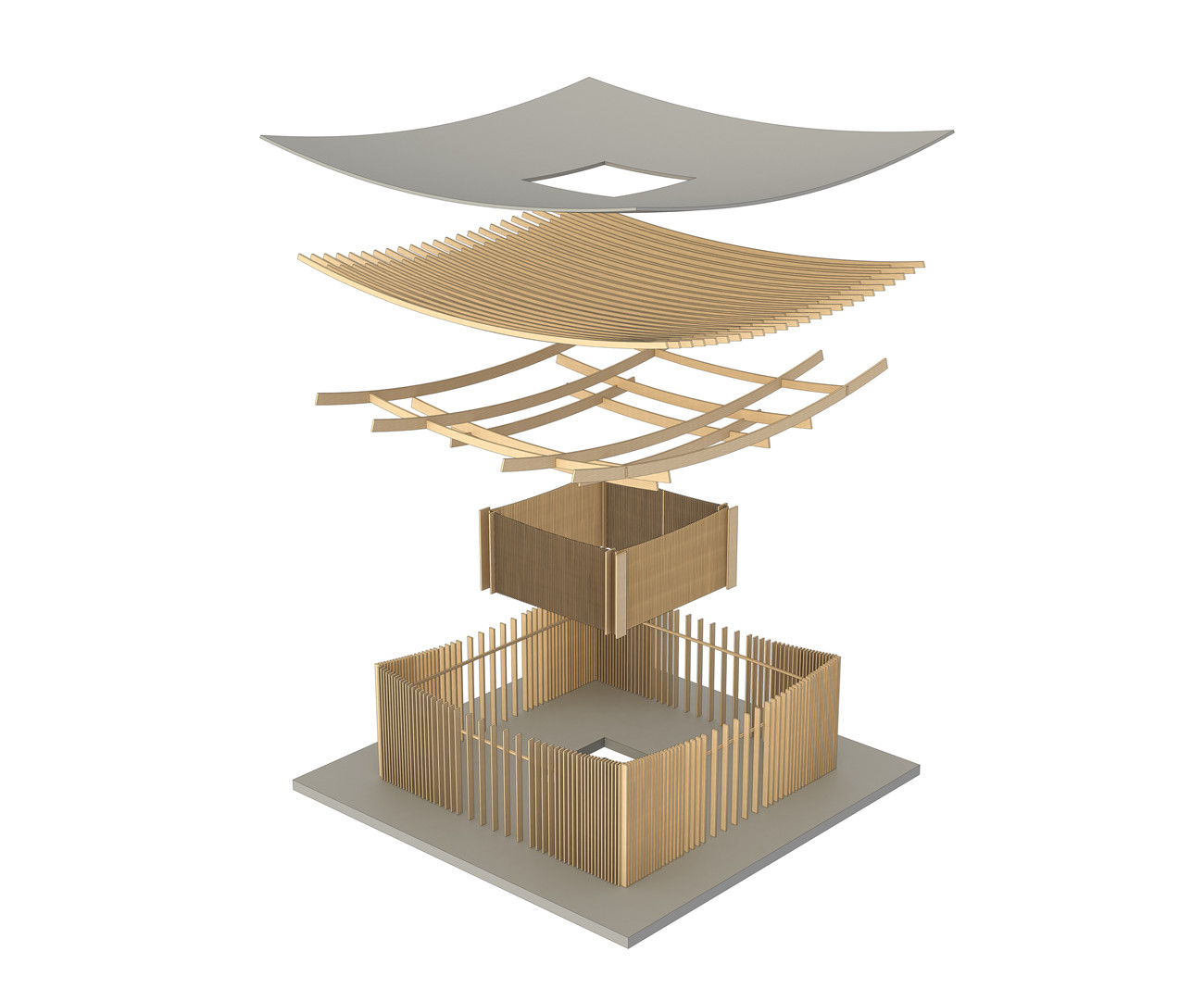
在布局上,茶室东侧立面与接待堂东侧立面连接成一条轴线,以求得在主要视点透视线上的连贯性。茶室的总面积为109平方米,是一个 “L”形的半围合院落,一端契入山体,另一端延伸、挑出到池塘上空。转折处的屋角约8米高,指向东南向的天空。这个“屋角”成为三条山谷会合处,空场的标识物;也和接待堂呼应,成为轴线上的制高点。屋面连续向两端陡降,形成一个狭长的内斜屋顶。
The tea room's east facade is on the same axis with the east facade of the reception hall, achieving coherence in major viewpoints' perspective line. Total area of the tea room is 109m2. One side of the room is embedded in the mountain, the other side stretches out upon the pond, forming a half-closing L-like yard. Room corner around turning point is 8m high, pointing to the southeast sky. This "room corner" has become a marker where three valleys converge together as well as the top point that correspond to the reception hall on the axis. The roof slopes continuously toward both sides, forming a long and narrow angled-in roof.
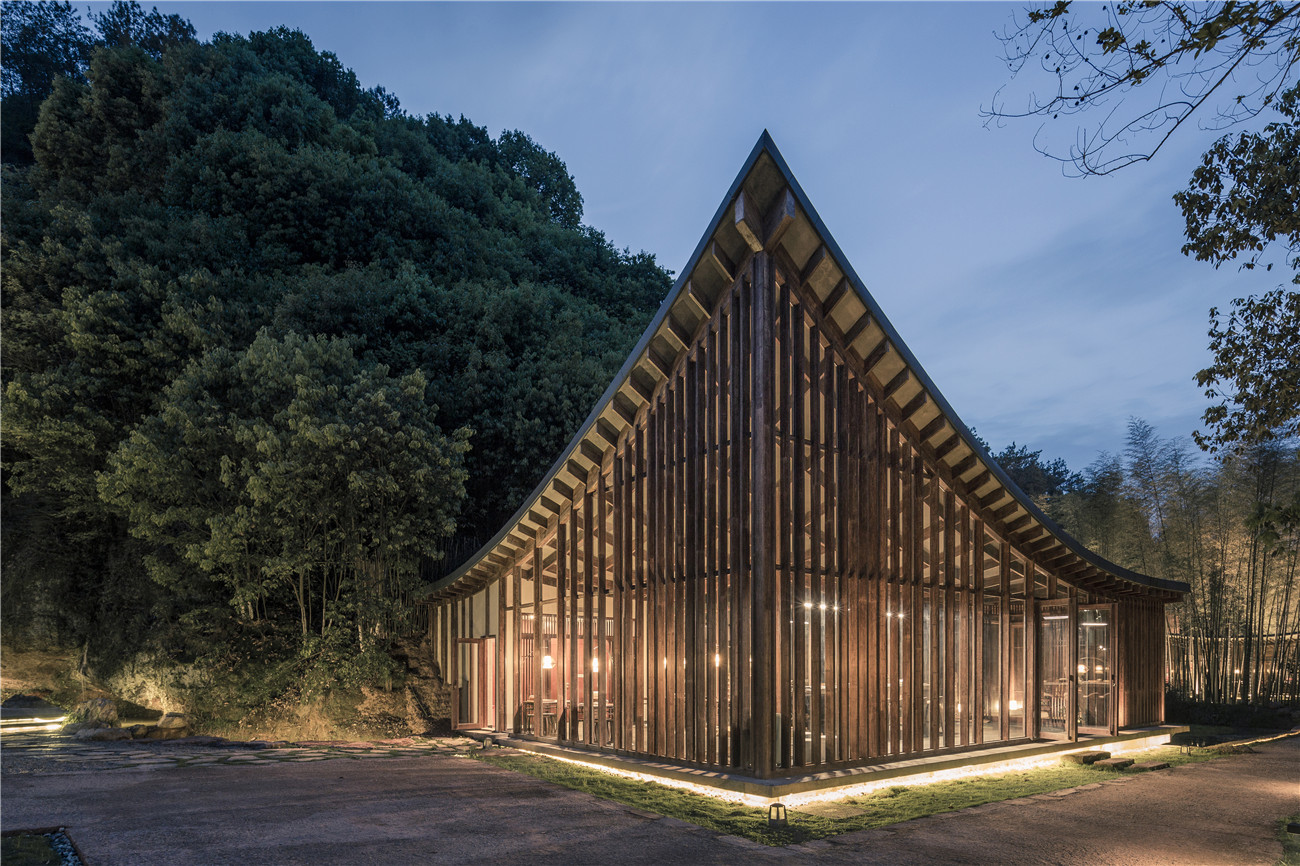
立面通高的玻璃幕墙不仅为人们带来了更宽阔的视觉体验,还给室内提供了充足的自然光线。
The glass wall brings broader visual experience and sufficient natural light for the indoor space.


书院与先生房位于西侧的谷内,隐藏在一片茂密的竹林之后。随坡而上,一侧是小溪,一侧是茂密的竹林。路尽头是书院的入口大门,它位于白色院墙左侧,和右侧越过白墙挑出的休息室共同形成均衡的构图关系。
Academy and teacher's room are in the western valley which is hidden behind a dense bamboo forest. Walking upwards along the slope, there is a stream on one side and a dense bamboo forest on the other. At the end of the road is the entry to the academy, which is located on the left side of the white wall, forming a balanced composition with the lounge on the right side.
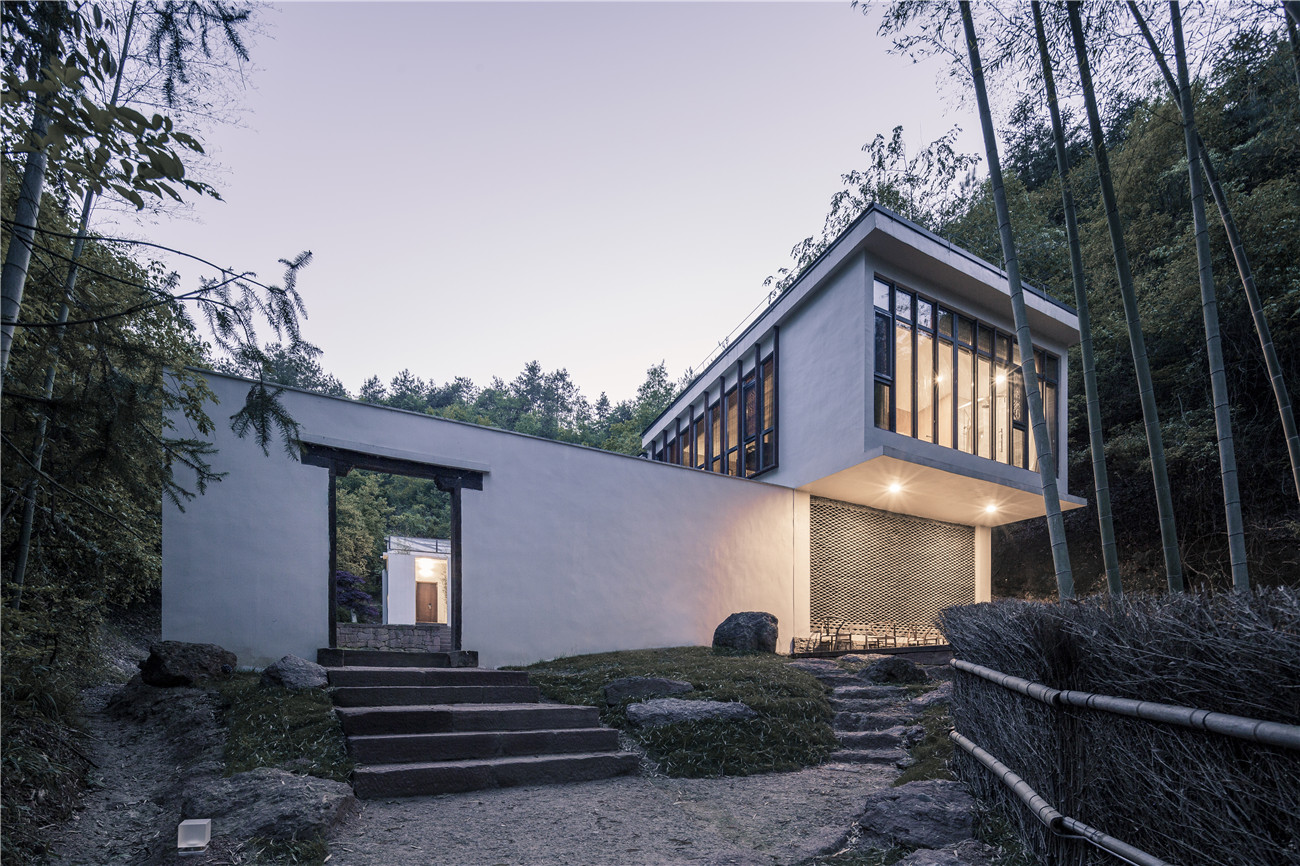
进入大门,U形的庭院才清晰可见:庭院被台地分成两级,连接着两个单体,错落的空间关系带来了更丰富的景观体验。建筑看似由两栋独立的单体构成,但通过相同的结构和材质,使两者之间形成一种整体的关联。书院建筑的屋顶从两侧向内倾斜,并由远及近逐层错落,形式与周边山势轮廓相呼应,回应周边的景观关系。
A U-shaped yard jumps into the eyes once entering the door. The yard is divided into two levels by a platform which connects two units. The well-arranged space forms an abundant landscape experience. The architectures which seem to be formed by two independent buildings can be regarded as a whole because of the same structure and materials. The roof of the academy slopes from both sides to the middle part and distributes layer by layer from far to near, forming a lineament echoing the surrounding mountains and answering the landscape around.
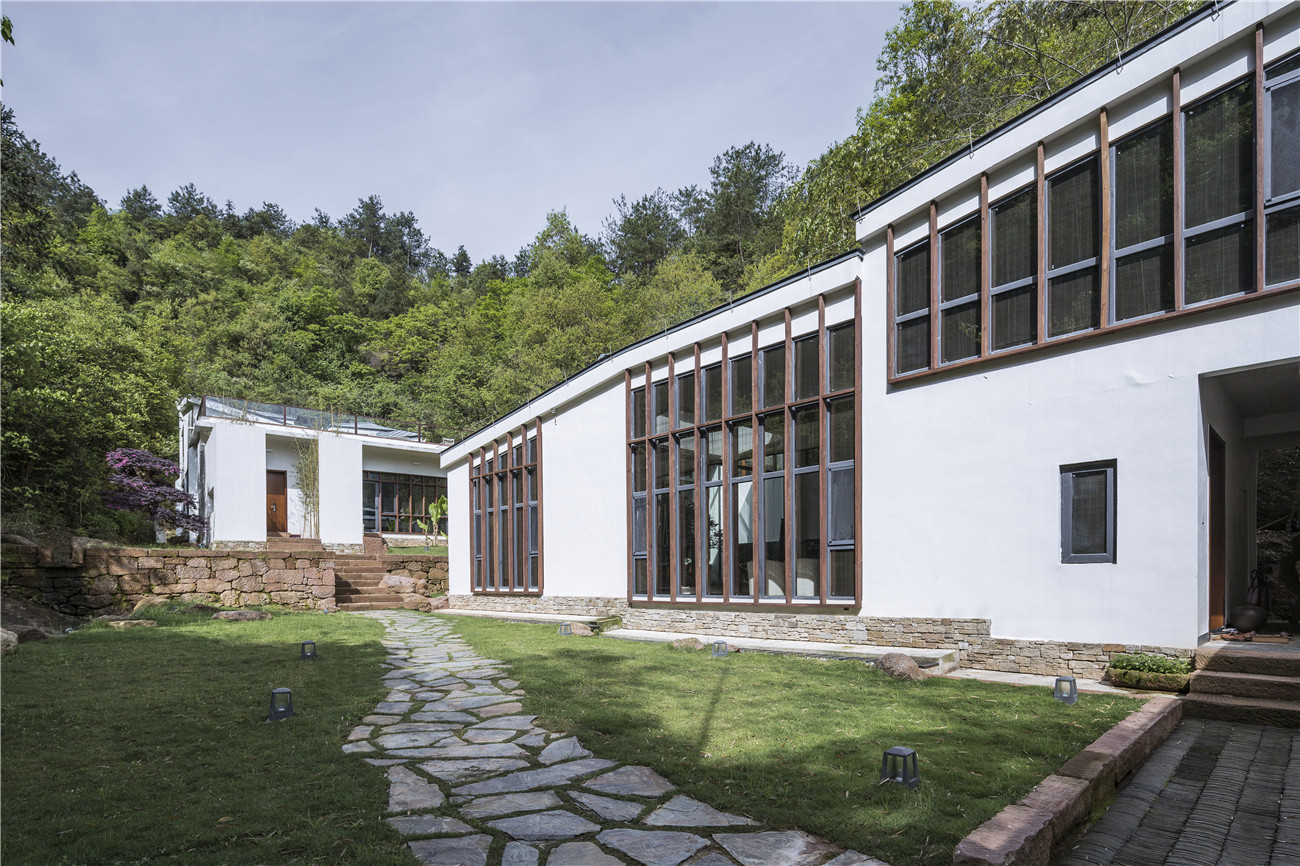
86米长的狭长建筑形体随山谷曲折,只在谷口保留了一个完整而突出的立面。依山势而下的溪水在建筑周围汇聚成水面,将入口映射其中,形成安详而静谧的画面。
In general, the 86m long and narrow form winds along the valley, leaving a complete and prominent facade on the valley mouth. The stream which flows downwards along the mountain converge around the architecture and form a peaceful and tranquil picture.
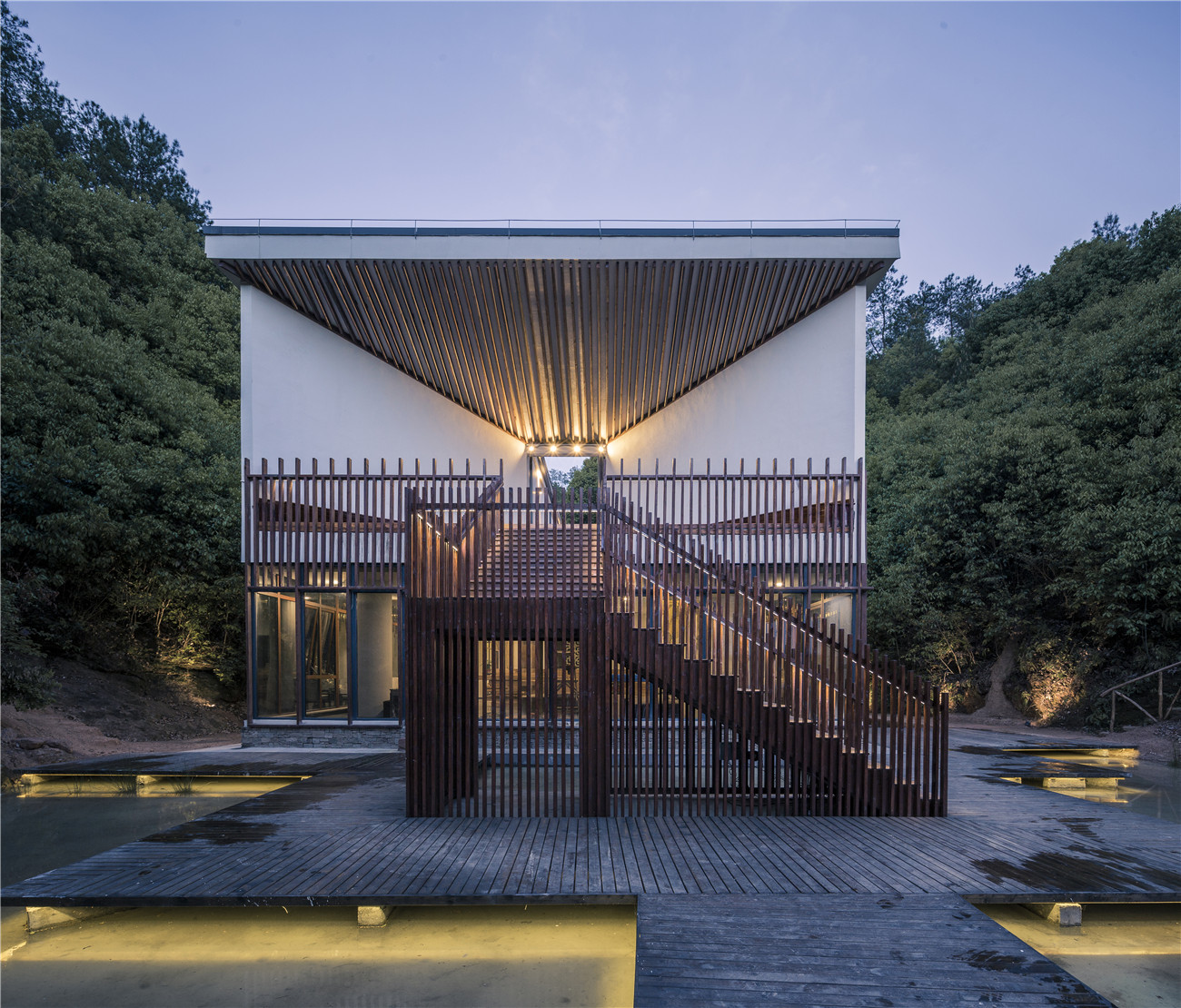
这一建筑单体总面积约1100平方米,形态契合原有的山谷地形,呈折线形随地势逐级抬高,通过高低错落的坡屋顶围合成具有南方乡村特征的巷道空间。巷道两侧的客房屋顶成V字形态,与接待堂,书院建筑的总体的形态一致。单坡屋顶为客房室内提供了更好的观山视野。
This architecture, with a total area of 1,100m2, has its form tallied with the original valley terrain completely, presenting a situation of raising broken line with the terrain. The sloping and well-arranged roofs form a lane space with features of southern countryside. The guest room roofs on both sides of the land are V-shaped, which are the same with the reception hall and the academy on general form. Lean-to, with respect to guest rooms, provides better view to see the mountains from indoor.
一层在结构上是底部架空的附属空间,三分之二的面积埋入山体之中,设置有多功能的休闲大厅、咖啡水吧,以及一个小型会议室。一层在交通组织上和二层是分别设置,所有的客房均位于二层,客人需通过主入口的景观楼梯单独进入二层小巷,使二层的客房区相对安静独立。18间客房沿着小巷两侧分布。
The first floor becomes an affiliated space built on stilts on structure. It's decorated into a multi-functional lounge, coffee and water bar and a small meeting room; besides, two third of the area is embedded in the mountain. The first floor differs with the second on traffic organization. All the guest rooms are placed on the second floor, which could be entered from the observation elevator in the main entrance independently only, making the guest rooms on the second floor quiet and independent. 18 guest rooms are distributed on both sides along the lane.

这栋建筑在形态上与山谷客房有着相似之处,主立面都迎着谷口的端头立面设置,并将主要体量隐匿在谷中。
This building is similar to the valley guest rooms in architectural form because the main facade of the architecture is set on the side of the valley mouth and its main body is hidden in the valley.
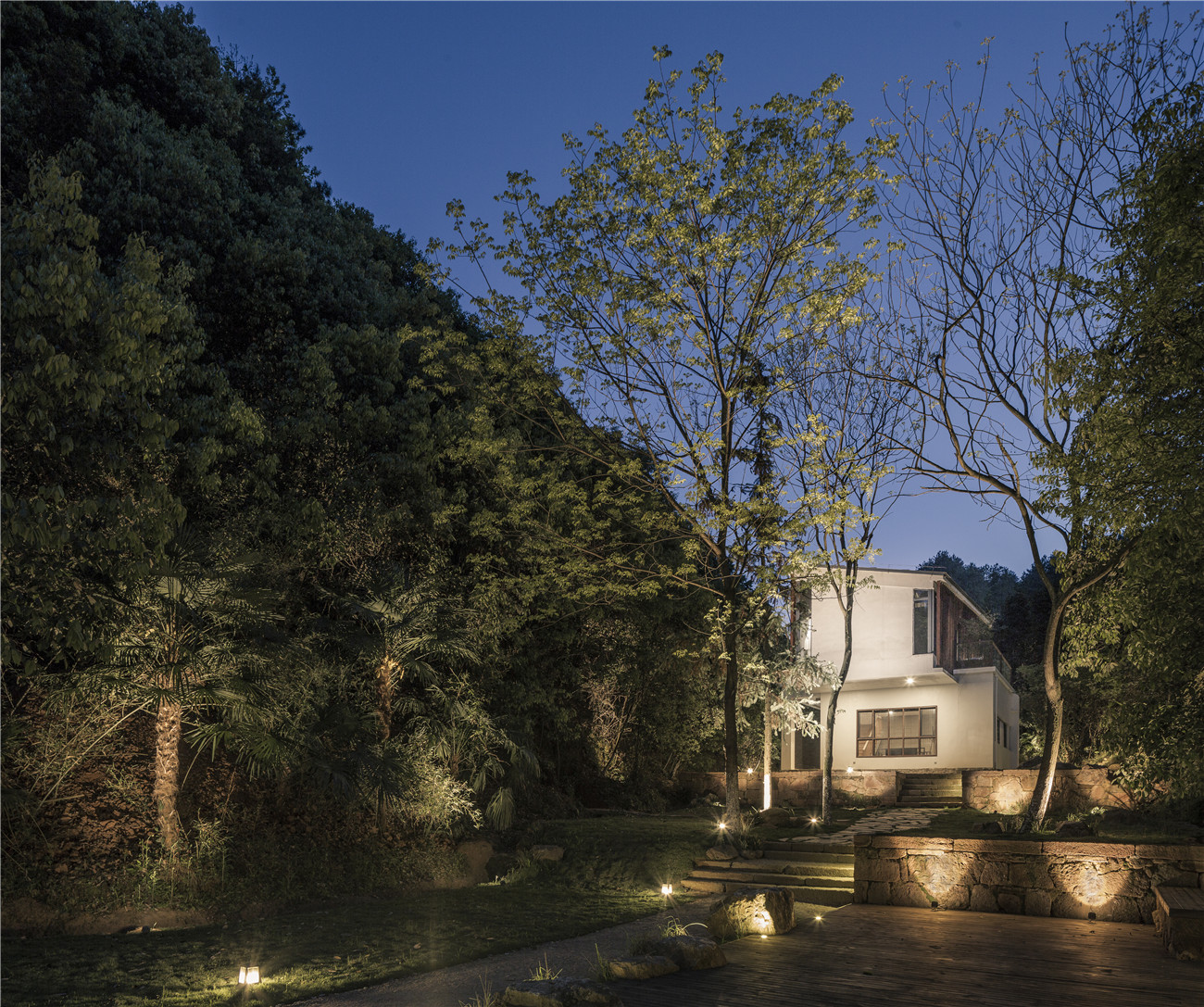
建筑随着山谷地形走势呈现折线关系布置。一层有三个独立的“盒子”,主要为公共活动空间,几处半户外的“亭子”空间穿插其间,由一条边廊连接。二层为卧室等私密空间,成线状排布成一条通长的“廊桥”结构,连续的竹钢格栅立面增加了“廊桥”在结构视觉上的整体性。多数状态下二层独立分割成卧室等私密功能,只在必要时可以通过二层的走道相连接。三角屋面的折面关系使整体形态与传统坡屋顶更相似。
The architecture is arranged along the valley on a broken line. There are three independent "boxes" on each floor, which are public activity space, among which are several half-outdoor "pavilion" spaces. These spaces are connected by a corridor. Private space such as bedrooms are arranged in line on the second floor just like a "gallery bridge". The continuous bamboo steel grating facade increases the integrity of the "gallery bridge" visually. On the actual functional partitioning, the private space such as bedrooms on the second floor, when using, are independent and separated; only when necessary, they could be connected through the aisle on the second floor. The triangular folding relationship of the roof makes the integral shape more similar to traditional roof.

双溪书院的所有建筑单体都几乎全部采用V字形内倾的屋顶形式,这也源自平江传统民居院落的剖面关系。这种剖面关系在四分别墅中反映的更为直接。内倾屋面的四个体块成为四个独立的休息空间,体块与外围墙界定的区域即为巷道和公共区域。这种类似聚落的形式也使整个建筑更适应场地,并避免体量过大带来的突兀感。四个独立的功能体块与一个通透的玻璃盒子相互套嵌,产生了居者在室内外不断交互的空间体验;同时,通过围墙的隔挡形成独立的六个小院子,在室内,透过围墙上局部的取景窗洞,使庭院中的人造景观与户外的自然景观形成一个重叠对景的关系。
Almost all the architectures in Shuangxi Academy adopt a V-shaped introvertive roof, which is derived from the profile of traditional courtyard in Pingjiang. Such a profile is reflected at quartered villas more directly. The four blocks of the introvertive roof become four independent spaces for rest. The areas defined by the block and the outer wall are galleries and public areas. Such a form similar to cluster makes the whole architecture more integrated into the site and avoids the congruous sense caused by the huge volume. Four independent functional blocks are inserted into a transparent glass box, producing a spatial experience of traveling between indoors and outdoors continuously; at the same time, six small yards are formed by walls. The partial viewing windows on the wall bring with opposite scenery created by the artificial landscape in the yard and the natural scenery outside the door.

通透的玻璃盒子将南侧的自然光引入室内,使建筑形象变得更加柔和。走出室内,从更远的视角观察,翘起的屋檐与两侧逐渐升高的山脊线互相呼应,削弱了正立面的视角应有的体量感。
The transparent glass boxes bring the natural light from the south side into the room, making the architectural image softer. Walking outside the room and viewing from a further visual angle, you will find that the tilted roof of the architecture and the ridge line gradually rising on both sides echoing each other, even though the sense of volume of front elevation from the facade is therefore weakened.
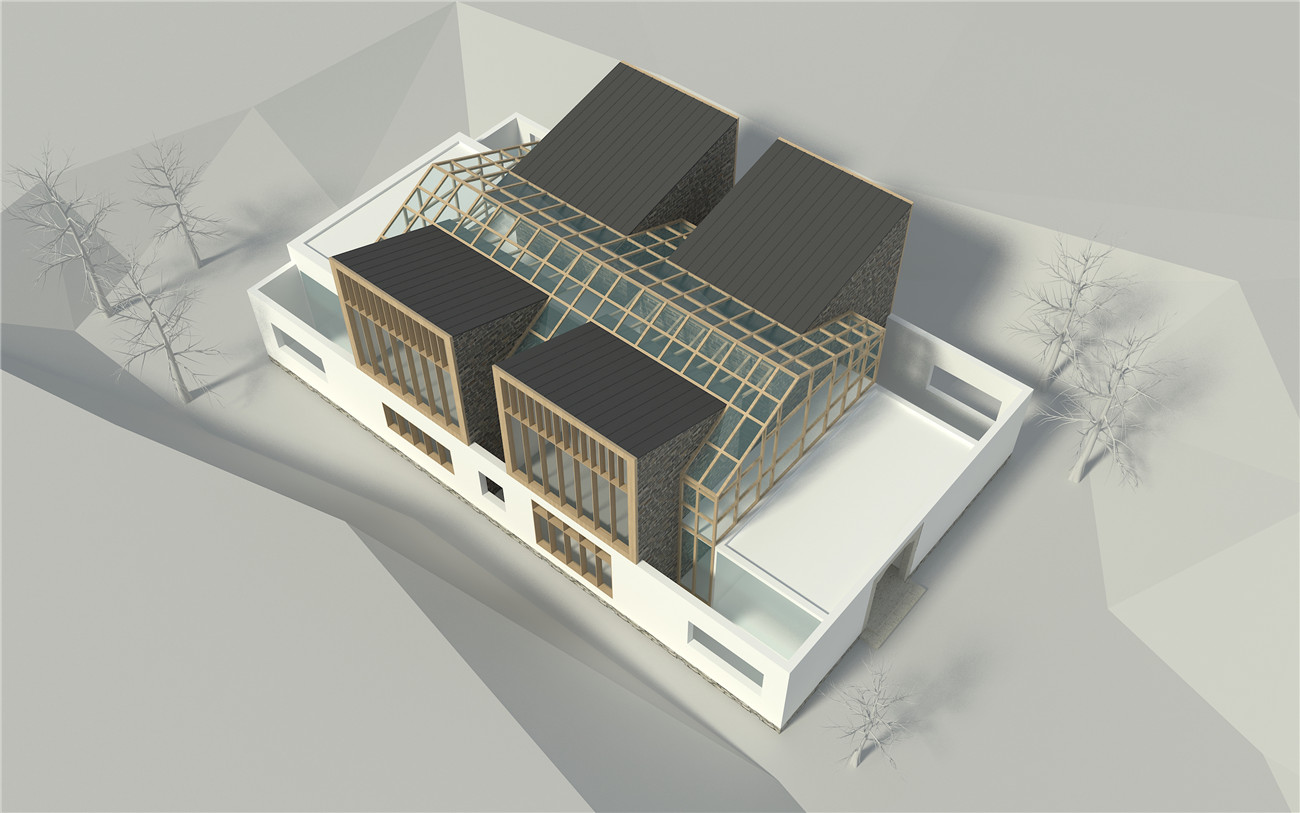
当建筑契入自然时,一切所谓专业的设计或阐释都应当顺从于自然的某种“力”或“势”。自然的包裹使建筑必然由对抗转到顺从,形成融入或共生。就如中国山水画中若影若现于山水之间的房子,这种画面中的诗意似乎拉近了我们和古人的距离。今天我们仍然努力在自然与建筑之间创造某种情景,某种能通过建筑与自然对话的情景。在双溪书院,游走在这幽邃的山谷之中、小溪之畔时,很容易使人想起南宋平江文人邹輗的诗句:花阴不正月将西,欲到溪边步懒移。坐对前山无一语,此心惟有古人知。
When an architecture is inverted in the nature, all the so-called professional design or explanation should submit to the "force" or "tendency" of the nature. The enclosure of the nature makes architectures turning from confrontation to obedience, or to integration or mutualism. For example, houses in Chinese landscape painting are partly hidden and partly visible between hills and waters. The poetry in such paintings narrows the distance between the ancients and us. Today, we are still trying to build some scenes between the nature and architectures, some scenes for us to communicate with the nature through architectures. Such scenes might be hidden in Shuangxi Academy. When walking in the deep valley and beside the quiet stream, we may think of the verse of Zou Ni, a litterateur of the Southern Song Dynasty: "The flower shadow turns oblique and the moon westwards, I am not in the mood to move when I'm in the brook. I say nothing in front of the mountain, as only the ancients know what I'm thinking about."

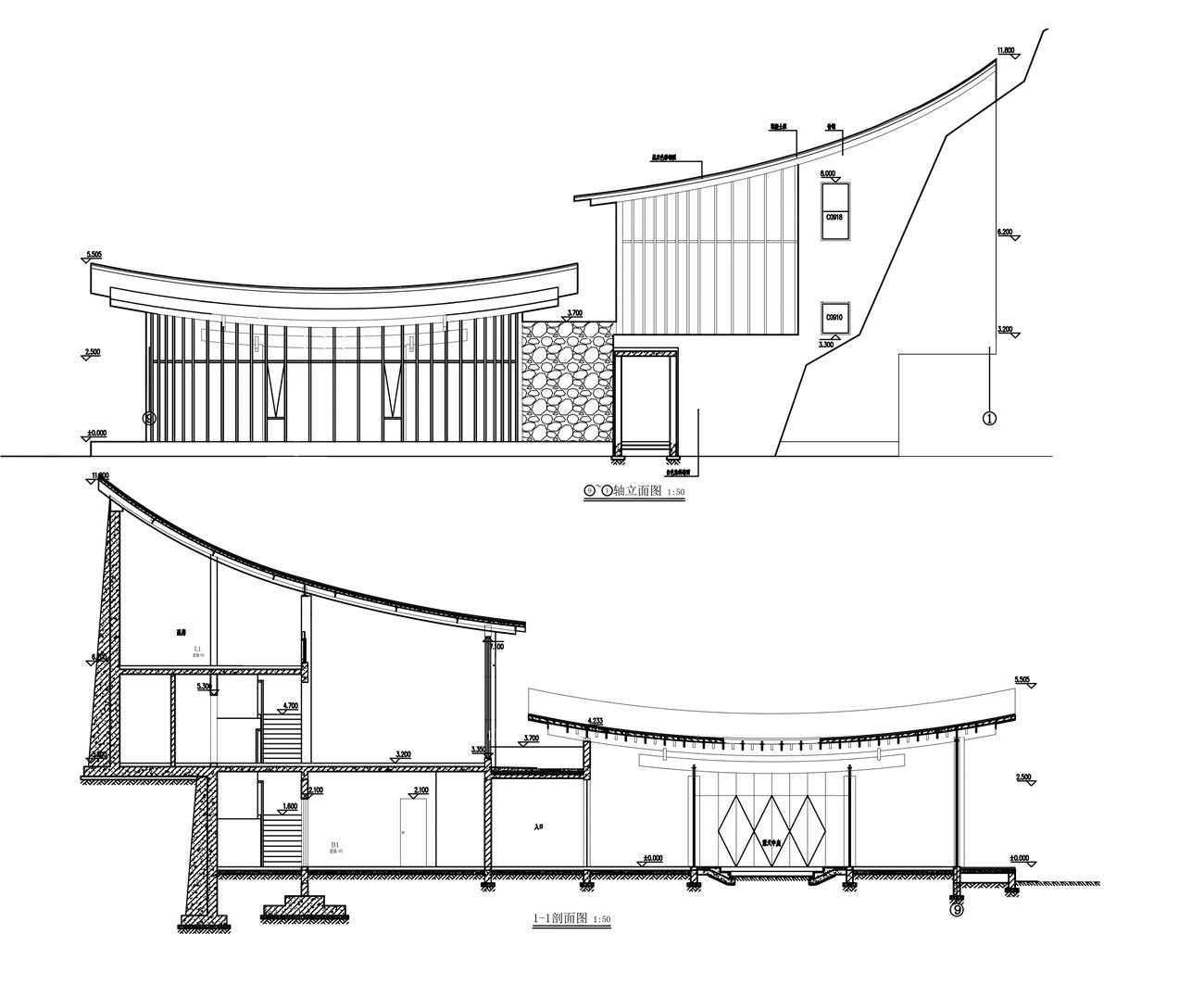
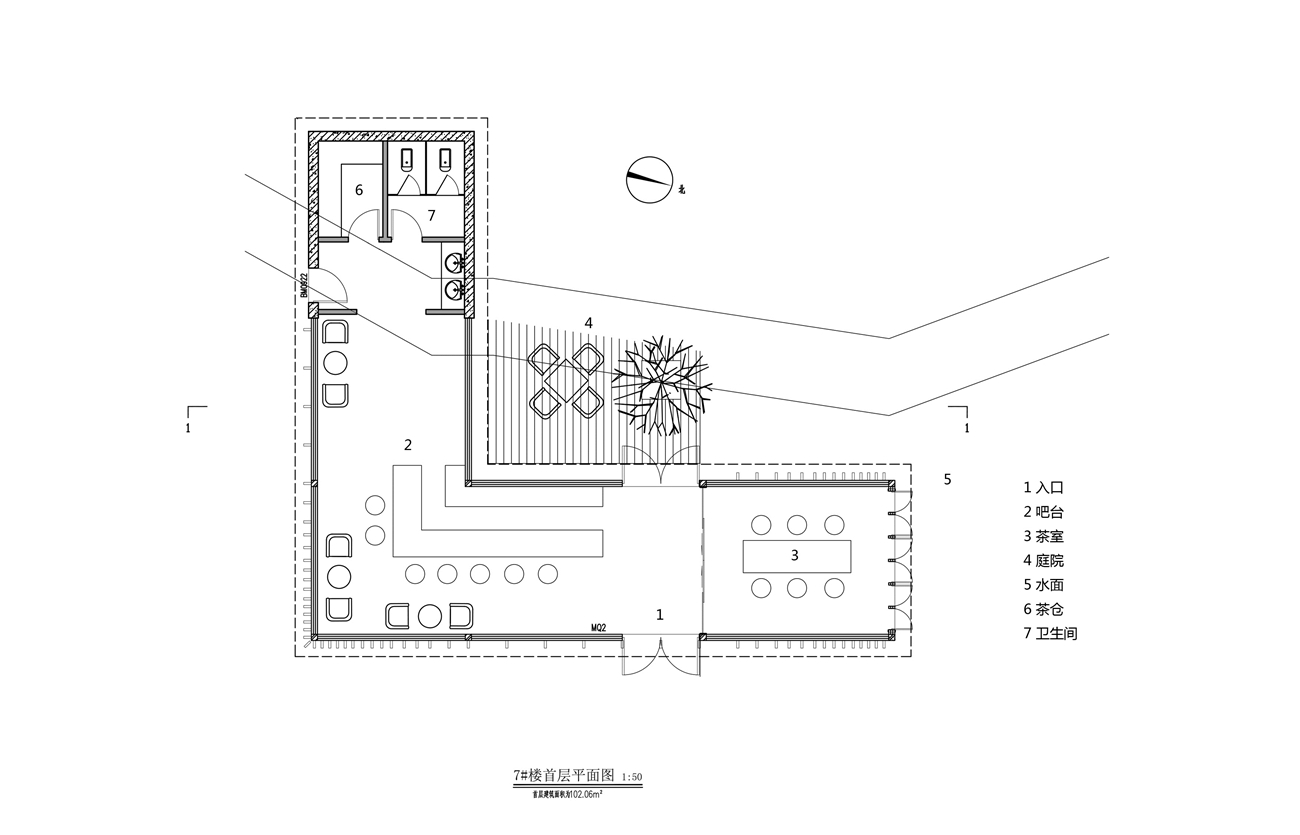
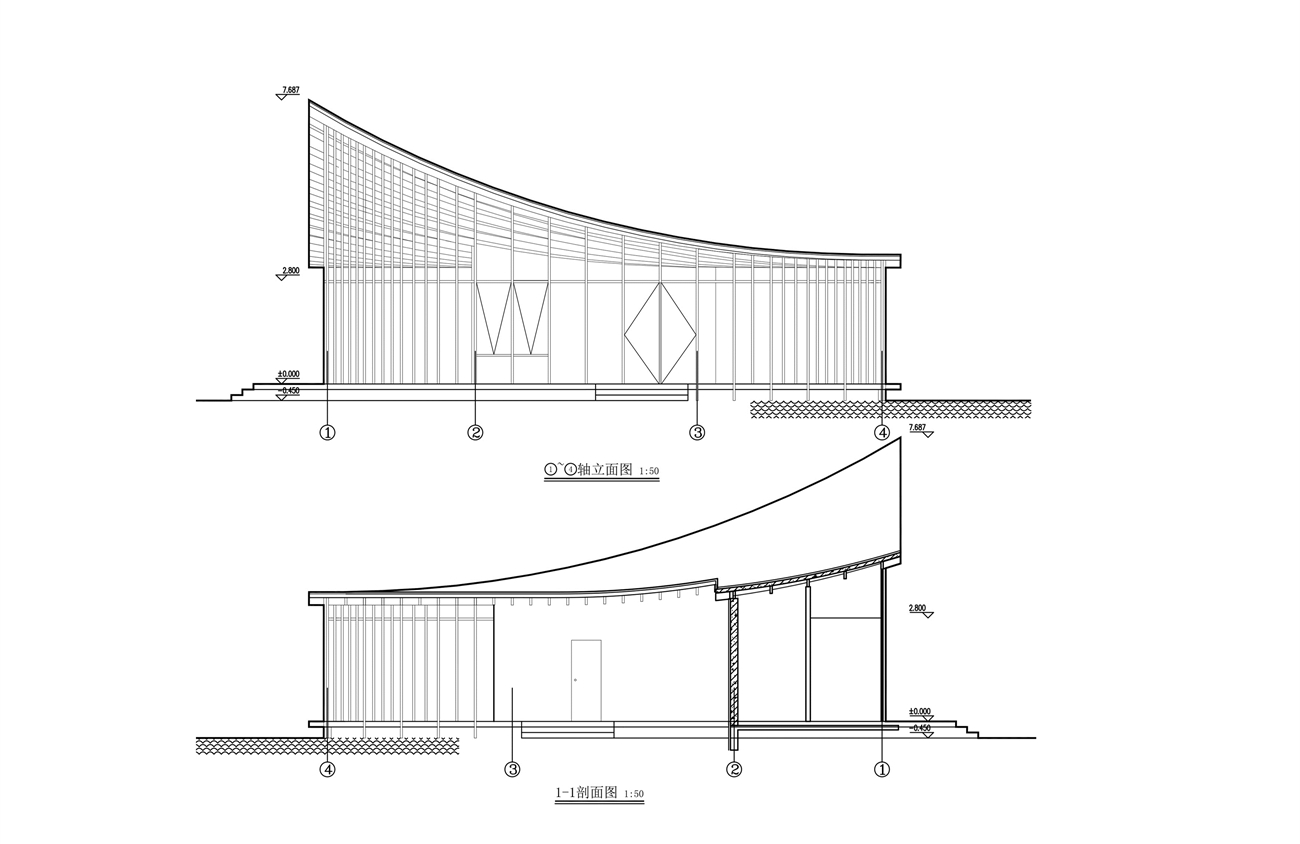


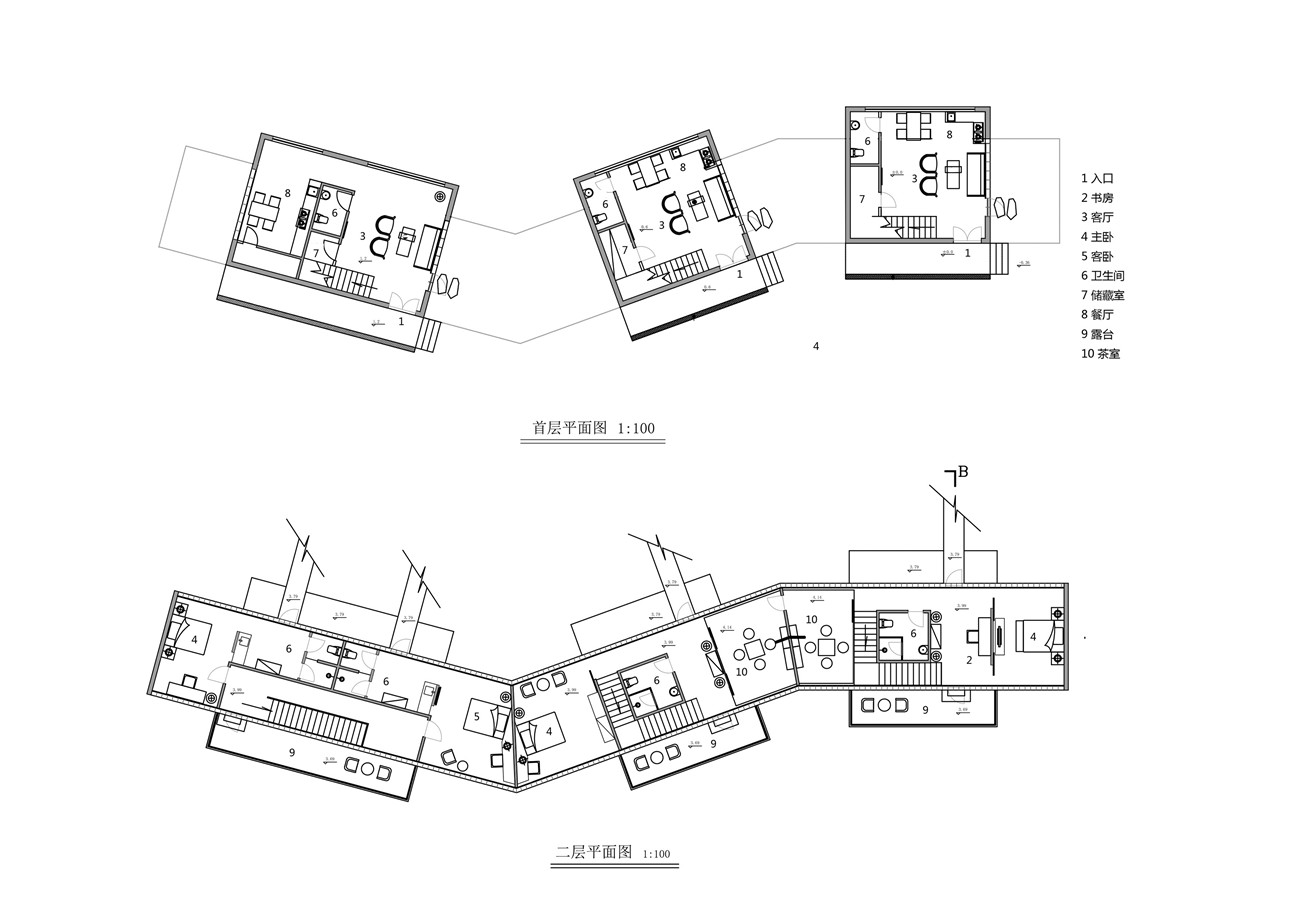
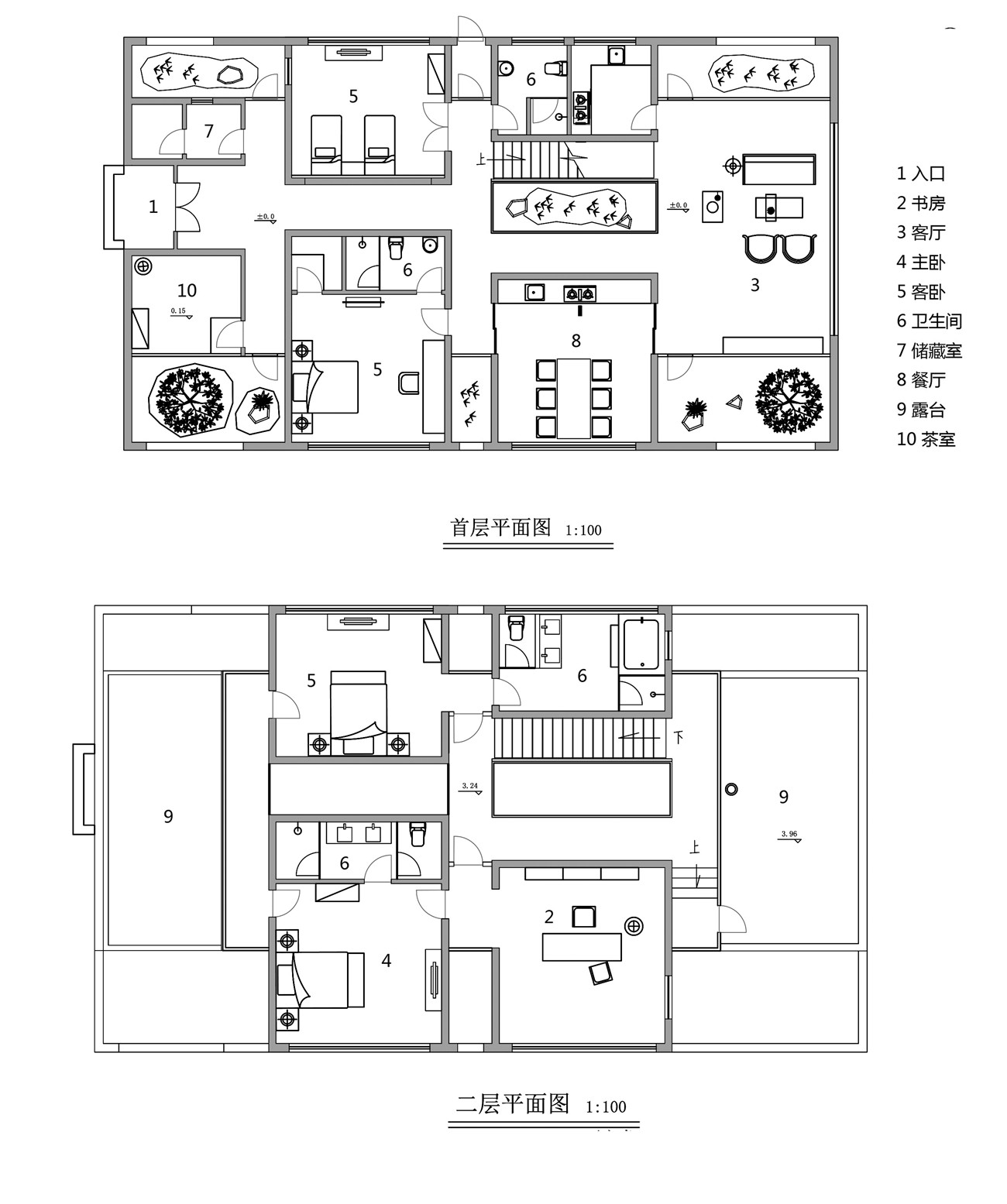
完整项目信息
项目地点:湖南省平江县白茅村
开发团队:自在小隐酒店(湖南)有限公司
项目总顾问:王受之
项目策划:崔东晖
建筑设计:北京多向界建筑设计
主持设计:李亮
设计团队:张必昌、黄畅、徐林
建筑面积:3800平方米
建造时间:2014年6月—2018年3月
建筑摄影:金伟琦
Project site: Baimao Village, Pingjiang County, Hunan Province
Development team: Zizaixiaoyin Hotel Co., Ltd., Hunan
Project general consultant: Wang Shouzhi
Project Planning: Cui Donghui
Architectural design: Beijing Duoxiangjie Architectural Design Co., Ltd.
Principal Designer: Li Liang
Design team: Zhang Bichang, Huang Chang, Xu Lin
Building area: 3,800㎡
Construction time: June 2014 - March 2018
Cameraman: Jin Weiqi
版权声明:本文由北京多向界建筑设计授权有方发布,禁止以有方编辑后版本转载。
133****9666
7年前
回复